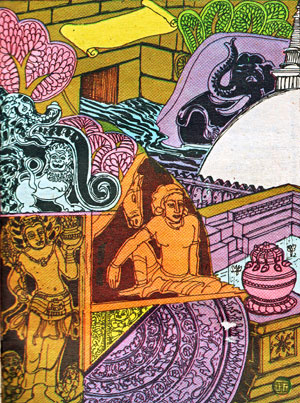 දේවානම්පියතිස්ස රජුගේ රාජ්යය රජරටට පමණක් සීමා වුණේ නැහැ. උතුර,දකුණ,සහ කදුකරය යන ප්රදේශ එකතු වී විශාල රාජ්යයක් රජු යටතේ පැවති අතර එකල රටේ ඒකීය පාලන ක්රමයක් ආරම්භ වූ බව පෙනී යනවා.
දේවානම්පියතිස්ස රජුගේ රාජ්යය රජරටට පමණක් සීමා වුණේ නැහැ. උතුර,දකුණ,සහ කදුකරය යන ප්රදේශ එකතු වී විශාල රාජ්යයක් රජු යටතේ පැවති අතර එකල රටේ ඒකීය පාලන ක්රමයක් ආරම්භ වූ බව පෙනී යනවා.
මිහිඳු හිමියන්ගේ පැමිණීමත්, ලංකා බුද්ධ ශාසනයේ ආරම්භයත් සිදු වූයේ දේවානම්පියතිස්ස රජු සමයේදී ය. බුදු දහමින් ලද පෝෂණය නිසා අනුරාධපුර රාජධානියේ උසස් සංස්කෘතියක් බිහි විය. සංස්කෘතිය යනු යම්කිසි ජන සමාජයක් තුළ පවතින විශ්වාස, ඇදහිලි, චාරිත්රර වාරිත්රර, ගති පැවතුම්, දැනුම, දක්ෂතා, කලා ශිල්ප ආදියේ එකතුව වේ.
අනුරාධපුරයේ කලා කෘති සරලය, චාම්ය. නමුත් ඒවා උසස් වින්දනයකට සිත පොළඹවයි. එකල සිංහල කලාකරුවා බුදු දහමින් හික්මවන ලද දියුණු වූ මනසක් ඇතිව සිටි බවට කදිම නිදසුනකි පැරණි කලා කෘති.
King Devanampiyatissa’s hegemony was not only confined to the Rajarata. While a vast kingdom comprising the regions of the north, south and the hill country was under the king, the origins of a unitary system of administration is to be noticed at this time.
The arrival of the Maha Thera Mahinda , and the establishment of the Lanka Buddha Sasana took place during the time of king Devanampiyatissa. Due to the influence of Buddhism and advanced culture grew up in the Anuradhapura kingdom. Culture could be described as a cumulative of beliefs, faiths, customs and usages, behaviour, knowledge, skills, arts and crafts prevalent within a particular set of society.
The works of art of Anuradhapura are simple and not extravagant. But they stimulate the mind towards higher planes of appreciation. The ancient works of art bear ample testimony to the fact that the Sinhala artistes of the day were a lot possessed of a advanced state of mind being desciplined by Buddhism .
